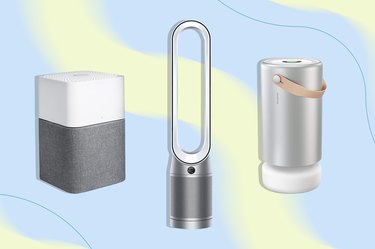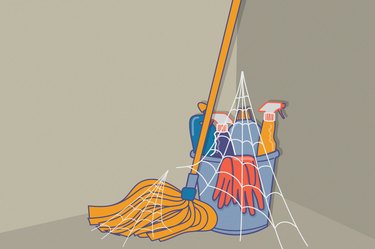
It's the end of a long work day and you want to disconnect. So you turn on some music, pour yourself a mug of herbal tea and light a scented candle.
But as your home fills with the warm fragrance of "gingerbread cookie," "cypress and sage" or "vanilla bean dream," could it also be filling with toxic chemicals that harm your health?
Video of the Day
Video of the Day
Here, learn whether candles are bad for you and how to safely burn them in your home.
The Health Effects of Burning Candles
Candles are a nearly $13 billion industry in the U.S., with sales steadily increasing by 5.7 percent a year, according to a market analysis report by Grand View Research. But despite their popularity, they're not great for indoor air quality.
When burned, candles release carbon monoxide, soot and chemical compounds into the air, including toluene and benzene, says Kavitha Gopalratnam, MD, pulmonologist and medical director of the respiratory therapy services department of Pulmonary, Critical Care and Sleep Medicine at Bridgeport Hospital, part of Yale New Haven Health.
You're likely familiar with carbon monoxide and soot, which aren't exactly good for air quality. Here's the scoop on toluene and benzene:
Toluene
"Toluene is often associated with the fumes emitted from paint thinners and can irritate your eyes, nose, throat and skin," Dr. Gopalratnam says. "It can also result in breathing-related disorders for people who are predisposed to respiratory issues."
Depending on your level of exposure, toluene can also lead to tiredness, confusion, dizziness, headache, anxiety and insomnia — as well as damage your kidneys, liver and nerves — according to the Centers for Disease Control (CDC).
Benzene
Meanwhile, benzene (one of the toxins released when smoking cigarettes) is no friendlier to your health. "Benzene is an industrial chemical that has a carcinogenic association," Dr. Gopalratnam says. (In other words, it has been linked to cancer.)
But before you freak out: Even though the National Cancer Association asserts that benzene exposure increases your risk of leukemia and blood disorders, Dr. Gopalratnam points out that a causal link between candle use and blood cancer has not been proven. And the amount of benzene emitted by candles is significantly lower than the amount generated by cigarette smoke.
Plus, keep in mind that, to some extent, the health implications of burning candles depend on the individual.
"People with preexisting lung disease like asthma are at slightly greater risk and should be a little more cautious," Dr. Gopalratnam says, noting that in extreme cases candle fumes can cause a severe asthma attack requiring an inhaler. Reactions also happen more commonly in children, as the fumes can be worse for them, she adds.
Are Scented Candles Worse?
Perhaps. Dr. Gopalratnam says there haven't been enough studies to show if scented candles are toxic. "But they are likely to contain volatile organic compounds, or VOCs, such as formaldehyde," she adds.
VOC exposure can lead to allergic reactions and exacerbate existing respiratory illnesses. Formaldehyde, for example, is highly toxic and a potential carcinogen, according to the CDC.
There's also been some recent research to support these claims. A January 2023 study in BMC Public Health found that nearly a quarter of university students who used scented candles reported health problems — including headache, shortness of breath and coughing — and that exposure to scented candles for an hour or more was associated with a higher incidence of headaches, sneezing and wheezing.
What's more, an October 2019 review in Cancer Prevention Research suggests that the aromatic compounds emitted when burning candles with fragrance are associated with an increased risk of bladder cancer.
Is it better if the fragrance comes from essential oils, rather than manufactured perfumes?
"Some studies have hinted that naturally occurring aromas are probably safe, whereas anything synthetic might be a little more dangerous," Dr. Gopalratnam says. Ultimately, though, the jury's still out.
How to Choose Safer Candles
The safest option is fragrance-free candles, but if you still want a pleasant smell, reach for a candle with natural wax and ingredients, or essential oils.
"Although the data is weak, it appears that paraffin-based candles, which are made out of a petroleum compound, can increase the release of formaldehyde into the air, compared to beeswax or plant-based wax like soy," Dr. Gopalratnam says.
Also, check the candle wick itself. "Many years ago, wicks used to contain lead," Dr. Gopalratnam says. "Although lead-containing candles have been banned, avoid colored or metallic wicks, which could contain toxic chemicals and cause health risks."
Undyed cotton, paper or wooden wicks are a safer option. (Peel apart the wick to make sure there's no metal inside.)
5 Ways to Use Candles More Safely
If you still want to burn candles in your home, here are tips to do so while staying healthy.
1. Increase Air Flow
"No matter what type of candle you are burning, some fumes can still be released into the air," Dr. Gopalratnam says. "So keep lit candles in a well-ventilated room."
Open windows or doors for cross-ventilation. If you put a candle in the bathroom, turn on the overhead fan.
2. Take Fire Safety Precautions
"Keep candles away from anything flammable," Dr. Gopalratnam says. The U.S. Fire Administration suggests placing them at least a foot away from anything that could burn. Avoid using them in bathrooms or bedrooms, and put them out before you go to bed.
You should also keep the wick of your candle trimmed to about a quarter inch, per the Cleveland Clinic. This will also decrease the amount of soot the candle produces when it burns.
3. Don't Blow Out Candles
"This can generate more smoke and fumes," Dr. Gopalratnam says, which can throw more soot into the air. "Use a snuffer to extinguish the flame instead."
You can also use a wick dipper, a long tool that will help you bend the lit wick into the wax, putting it out without smoke.
Try the Calary Candle Wick Trimmer set ($16.99, Amazon), which includes a candle snuffer, wick dipper and wick trimmer.
4. Toss Smoky Candles
If you notice smoke emanating from the candle wick, get rid of it. "A smoky candle means toxins and particulate matter are being released into the air," Dr. Gopalratnam says.
Same goes if you notice a black soot ring building up on the glass around the candle.
5. Look Out for Allergy Symptoms
"Early signs of an allergic reaction or respiratory irritation from inhaling candle fumes include itchy eyes or nose, a runny nose and sneezing," Dr. Gopalratnam says. If you notice any of these, ditch the candle.
So, How Bad Is It Really to Light Scented Candles All the Time?
For most of us, it's OK. "Just take care to use them in a safe manner, which includes buying high-quality, natural candles and placing them in a well-ventilated room," Dr. Gopalratnam says. And: "If the candles have aromatic compounds in them, assess if you might be having an allergic reaction."
Take added precautions if you have a pre-existing allergy or respiratory condition.
- Grand View Research: "Candle Market Size, Share & Trends Analysis Report By Product (Votive, Pillars, Tapers, Container Candle), By Wax Type (Paraffin, Beeswax), By Distribution Channel (Offline, Online), By Region, And Segment Forecasts, 2023 - 2030"
- CDC: "Toluene"
- National Cancer Association: "Benzene"
- CDC: "Formaldehyde"
- Cancer Prevention Research: "Scented Candles as an Unrecognized Factor that Increases the Risk of Bladder Cancer; Is There Enough Evidence to Raise a Red Flag?"
- BMC Public Health: "Extent of exposure to scented candles and prevalence of respiratory and non-respiratory symptoms amongst young university students"
- U.S. Fire Administration: "Candles"
- Cleveland Clinic: "Can Burning Candles Be Bad for You?"
Is this an emergency? If you are experiencing serious medical symptoms, please see the National Library of Medicine’s list of signs you need emergency medical attention or call 911.






